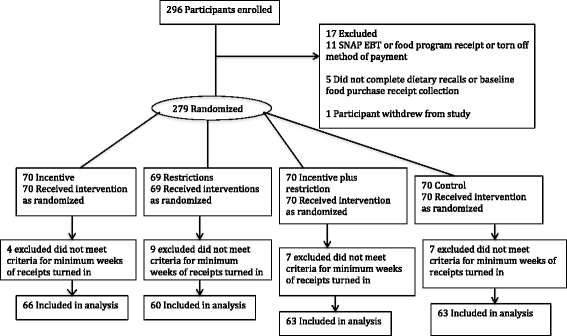Financial incentives and purchase restrictions in a food benefit program affect the types of foods and beverages purchased: results from a randomized trial
- PMID: 28915844
- PMCID: PMC5602848
- DOI: 10.1186/s12966-017-0585-9
Financial incentives and purchase restrictions in a food benefit program affect the types of foods and beverages purchased: results from a randomized trial
Abstract
Background: This research evaluated the effects of financial incentives and purchase restrictions on food purchasing in a food benefit program for low income people.
Methods: Participants (n=279) were randomized to groups: 1) Incentive- 30% financial incentive for fruits and vegetables purchased with food benefits; 2) Restriction- no purchase of sugar-sweetened beverages, sweet baked goods, or candies with food benefits; 3) Incentive plus Restriction; or 4) Control- no incentive or restrictions. Participants received a study-specific debit card where funds were added monthly for 12-weeks. Food purchase receipts were collected over 16 weeks. Total dollars spent on grocery purchases and by targeted food categories were computed from receipts. Group differences were examined using general linear models.
Results: Weekly purchases of fruit significantly increased in the Incentive plus Restriction ($4.8) compared to the Restriction ($1.7) and Control ($2.1) groups (p <.01). Sugar-sweetened beverage purchases significantly decreased in the Incentive plus Restriction (-$0.8 per week) and Restriction ($-1.4 per week) groups compared to the Control group (+$1.5; p< .0001). Sweet baked goods purchases significantly decreased in the Restriction (-$0.70 per week) compared to the Control group (+$0.82 per week; p < .01).
Conclusions: Paired financial incentives and restrictions on foods and beverages purchased with food program funds may support more healthful food purchases compared to no incentives or restrictions.
Clinical trial registration: Clinicaltrials.gov Identifier: NCT02643576 .
Keywords: Financial incentives; Food purchases; Low income; Restrictions; SNAP (supplemental nutrition assistance program).
Conflict of interest statement
Author information
Not Applicable.
Ethics approval and consent to participate
The University of Minnesota IRB approved the study. All participants consented to take part in the study.
Consent for publication
All authors consented to the present version of the manuscript submitted here.
Competing interests
The authors have no conflicts to report.
Publisher’s Note
Springer Nature remains neutral with regard to jurisdictional claims in published maps and institutional affiliations.
References
-
- Condon E, Drilea S, Jowers K, Lichtenstein C, Mabil J, Niland K. Diet quality of Americans by SNAP participation status: Data from the National Health and Nutrition Examination Survey, 2007-2010. In: Book Diet quality of Americans by SNAP participation status: Data from the National Health and Nutrition Examination Survey, 2007–2010. Walter R. McDonald & Associates, Inc: Mathematica Policy Research for the Food and Nutrition Service; 2015.
-
- Guthrie JF, Lin B-H, Ver Ploeg M, Frazao E. Can food stamps do more to improve food choices? In book can food stamps do more to improve food choices? Economic Research Service: US Department of Agriculture; 2007.
-
- Yen ST. The effects of SNAP and WIC programs on nutrient intakes of children. Food Policy. 2010;35:576–583. doi: 10.1016/j.foodpol.2010.05.010. - DOI
Publication types
MeSH terms
Substances
Associated data
Grants and funding
LinkOut - more resources
Full Text Sources
Other Literature Sources
Medical


